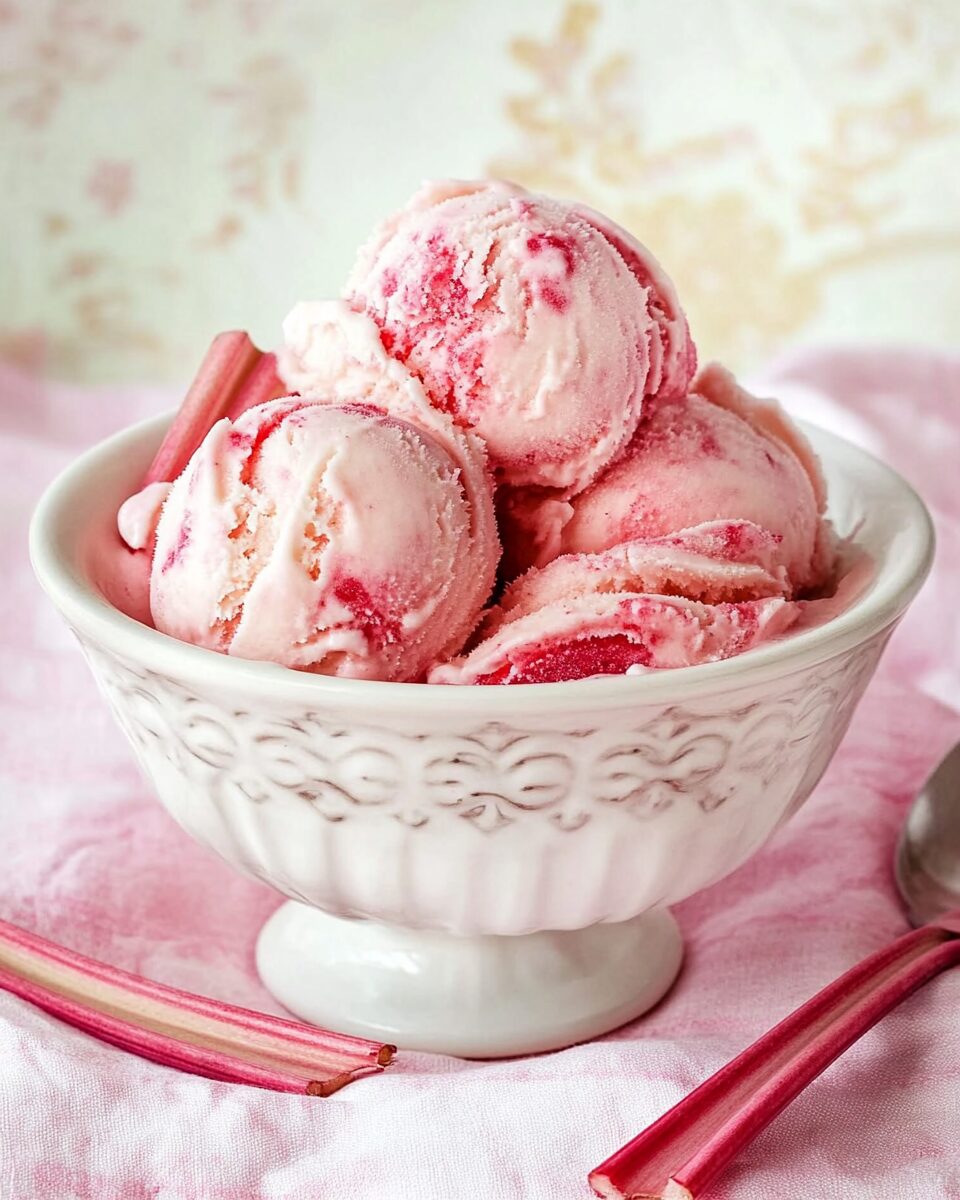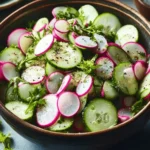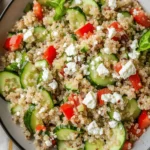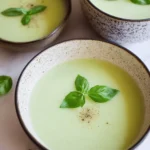A sweet-tart treat perfect for warm days, this creamy rhubarb ice cream blends the bright tang of rhubarb with a rich, smooth custard base. It’s an ideal make-ahead dessert that’s both refreshing and indulgent.
FULL RECIPE
Ingredients
- 3 cups chopped rhubarb (fresh or frozen)
- 1 cup granulated sugar (divided)
- 2 tablespoons water
- 1 teaspoon vanilla extract
- 2 cups heavy cream
- 1 cup whole milk
- 4 large egg yolks
- Pinch of salt
Directions
- In a saucepan, combine rhubarb, 1/2 cup sugar, and water. Cook over medium heat until rhubarb is soft and broken down, about 10-12 minutes.
- Remove from heat and stir in vanilla extract. Let the mixture cool slightly, then puree in a blender or food processor until smooth. Set aside to cool completely.
- In another saucepan, heat cream and milk over medium heat until just beginning to steam.
- In a mixing bowl, whisk together egg yolks, remaining 1/2 cup sugar, and salt until pale.
- Slowly pour the warm cream mixture into the egg yolks, whisking constantly to temper the eggs.
- Return the mixture to the saucepan and cook over low heat, stirring constantly, until it thickens enough to coat the back of a spoon (around 170–175°F).
- Strain the custard through a fine-mesh sieve into a clean bowl. Let cool to room temperature, then stir in the rhubarb puree.
- Cover and chill in the refrigerator for at least 4 hours or overnight.
- Churn the mixture in an ice cream maker according to manufacturer’s instructions.
- Transfer to a container and freeze for 2–4 hours until firm.
Nutritional Information
- Calories: 280 per serving
- Fat: 18g
- Saturated Fat: 11g
- Carbohydrates: 26g
- Sugar: 23g
- Protein: 3g
- Fiber: 1g
- Cholesterol: 120mg
- Sodium: 40mg
The History of Rhubarb in Desserts
Rhubarb has a long history as an ingredient in desserts, especially in temperate climates where it grows abundantly in spring and early summer. Originating in Asia, rhubarb was originally valued for its medicinal properties before becoming a culinary favorite. Its sharp, tangy flavor pairs well with sweetness, making it a classic component in pies, crumbles, and jams. Using rhubarb in ice cream is a more modern twist that highlights the vegetable’s versatility in cold desserts.
Why Rhubarb Works Well in Ice Cream
The natural tartness of rhubarb provides a refreshing contrast to the richness of cream and egg yolks in ice cream. This balance between tangy and creamy flavors creates a complex taste experience that is both invigorating and comforting. The acidity in rhubarb also helps cut through the heaviness of dairy, making the dessert feel lighter on the palate.
Seasonality and Freshness of Rhubarb
Rhubarb is a spring vegetable that peaks in freshness from April through June. Using fresh rhubarb ensures a bright, vibrant flavor and beautiful natural color in the ice cream. When fresh rhubarb is unavailable, frozen rhubarb can be used effectively without sacrificing much flavor, as it is often frozen at peak ripeness.
Texture Considerations in Rhubarb Ice Cream
Rhubarb’s fibrous texture can influence the mouthfeel of the ice cream. Pureeing the cooked rhubarb smooths out the fibrous bits, ensuring a creamy, consistent texture. Some recipes incorporate small chunks of cooked rhubarb to add bursts of texture, but a fully pureed mixture will give a silkier result.
Balancing Sweetness and Tartness
A critical aspect of making rhubarb ice cream is balancing the vegetable’s natural tartness with sugar. Too little sugar leaves the ice cream overly sour, while too much can mask rhubarb’s delicate flavor. Adjusting sugar levels based on the ripeness of the rhubarb and personal taste preferences is key to a perfectly balanced dessert.
The Role of Custard in Creaminess
The custard base made from egg yolks, cream, and milk is central to the luxurious texture of rhubarb ice cream. Egg yolks act as natural emulsifiers, preventing ice crystals from forming and providing a smooth, velvety finish. The richness of the custard complements the tangy rhubarb, resulting in a harmonious flavor and texture.
Using Vanilla to Enhance Flavor
Vanilla extract is often added to rhubarb ice cream to round out the flavor profile. The warmth and sweetness of vanilla soften the sharp edges of rhubarb and add aromatic complexity. It pairs well with the natural floral and fruity notes of rhubarb, making the ice cream more nuanced and enjoyable.
How to Cook Rhubarb for Ice Cream
Cooking rhubarb properly is essential to achieving the right flavor and texture. Gently simmering it with a small amount of sugar and water softens the stalks without turning them to mush. This cooking process releases the rhubarb’s natural juices and mellows some of its tartness while preserving its vibrant color.
The Importance of Cooling the Mixture Before Churning
Chilling the rhubarb custard mixture before churning is crucial for achieving a smooth texture. If the mixture is too warm when added to the ice cream maker, it can interfere with freezing and create a grainy texture. Cooling also allows the flavors to meld, resulting in a more harmonious final product.
Tips for Churning Ice Cream at Home
Homemade ice cream requires proper churning to incorporate air and prevent ice crystals. Using a well-chilled ice cream maker bowl and following the manufacturer’s instructions ensures the right texture. Over-churning can make the ice cream too stiff, while under-churning leaves it too soft or icy.
Storage and Serving Suggestions
Once churned, rhubarb ice cream benefits from a few hours of firm freezing before serving. Storing it in an airtight container helps maintain freshness and texture. This ice cream pairs beautifully with fresh berries, crumbled cookies, or a drizzle of honey for added contrast.
Variations to Customize the Recipe
The basic creamy rhubarb ice cream recipe can be adapted in many ways. Some prefer adding small chunks of rhubarb for texture, while others fold in toasted nuts or swirls of strawberry jam. Experimenting with spices like ginger or cardamom can introduce interesting new flavor dimensions.
Health Considerations
While rhubarb itself is low in calories and rich in antioxidants, the ice cream base adds fat and sugar, making this dessert indulgent rather than a health food. Moderation is key, but enjoying a serving of rhubarb ice cream can be part of a balanced diet when savored mindfully.
Allergen Information
This recipe contains dairy and eggs, common allergens. For those with allergies or intolerances, alternatives such as coconut milk or egg substitutes can be explored, but these will affect the texture and flavor and may require recipe adjustments.
Pairing Rhubarb Ice Cream with Other Desserts
Rhubarb ice cream can be a delightful accompaniment to warm desserts such as apple pie or gingerbread. The cold, tangy creaminess contrasts beautifully with hot, spiced baked goods, creating a dynamic flavor and temperature experience.
Cultural Variations of Rhubarb Desserts
Around the world, rhubarb features in various traditional desserts. In Scandinavian countries, it’s often paired with cardamom or almonds. In the UK, rhubarb crumble is a beloved classic. Understanding these variations can inspire creative twists when making rhubarb ice cream.
Environmental Impact of Rhubarb Cultivation
Rhubarb is a hardy perennial that requires relatively low water and fertilizer compared to many fruits. Growing rhubarb locally can reduce environmental impact and support sustainable food practices, making rhubarb-based recipes both delicious and eco-friendly.
Storing Rhubarb Before Use
Fresh rhubarb should be stored in the refrigerator wrapped in plastic or a damp cloth to maintain freshness. It can last up to two weeks if kept cool and moist. Proper storage ensures the best flavor and texture when incorporated into recipes.
Common Mistakes to Avoid
Overcooking rhubarb can cause it to lose its bright flavor and turn mushy, while under-sweetening can leave the ice cream unpleasantly tart. Another frequent error is skipping the cooling step before churning, which can ruin the ice cream’s texture.
How to Make the Recipe Vegan or Dairy-Free
For a vegan or dairy-free version, substitute coconut milk or almond milk for dairy and use a plant-based egg replacer or cornstarch to thicken the custard. These alternatives change the texture and flavor but still yield a tasty rhubarb frozen dessert.
Conclusion
Creamy rhubarb ice cream is a unique and flavorful dessert that combines the tartness of rhubarb with the richness of a custard base. Its balance of textures and flavors makes it a standout treat for spring and summer. Whether enjoyed on its own or paired with other desserts, this ice cream offers a refreshing and indulgent experience that celebrates the versatility of rhubarb. With thoughtful preparation and attention to detail, anyone can create this delightful dessert to impress family and friends.






